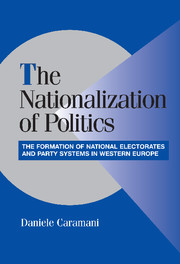 The Nationalization of Politics
The Nationalization of Politics Book contents
- Frontmatter
- Contents
- List of Tables
- List of Figures
- Abbreviations and Symbols
- Preface and Acknowledgments
- INTRODUCTION: HOMOGENEITY AND DIVERSITY IN EUROPE
- Part I Framework
- Part II Evidence
- Part III Toward an Explanation
- 6 THE DYNAMIC PERSPECTIVE: STATE FORMATION AND MASS DEMOCRATIZATION
- 7 THE COMPARATIVE PERSPECTIVE: NATION-BUILDING AND CULTURAL HETEROGENEITY
- CONCLUSION: FROM TERRITORIAL TO FUNCTIONAL POLITICS
- Appendix 1 Party Codes
- Appendix 2 Territorial Units
- Appendix 3 Computations
- Appendix 4 Country Specificities
- Appendix 5 Sources
- References
- Index
- Cambridge Studies in Comparative Politics
7 - THE COMPARATIVE PERSPECTIVE: NATION-BUILDING AND CULTURAL HETEROGENEITY
Published online by Cambridge University Press: 02 December 2009
- Frontmatter
- Contents
- List of Tables
- List of Figures
- Abbreviations and Symbols
- Preface and Acknowledgments
- INTRODUCTION: HOMOGENEITY AND DIVERSITY IN EUROPE
- Part I Framework
- Part II Evidence
- Part III Toward an Explanation
- 6 THE DYNAMIC PERSPECTIVE: STATE FORMATION AND MASS DEMOCRATIZATION
- 7 THE COMPARATIVE PERSPECTIVE: NATION-BUILDING AND CULTURAL HETEROGENEITY
- CONCLUSION: FROM TERRITORIAL TO FUNCTIONAL POLITICS
- Appendix 1 Party Codes
- Appendix 2 Territorial Units
- Appendix 3 Computations
- Appendix 4 Country Specificities
- Appendix 5 Sources
- References
- Index
- Cambridge Studies in Comparative Politics
Summary
In spite of the general trend toward the nationalization of party systems described in the previous chapter differences between countries in regard to the levels of territoriality of voting behavior have not disappeared. In some countries, territorial politics plays an important role to this day. In other words, although there are common factors leading to the nationalization of all party systems (state formation and democratization processes leading to a predominantly functional dimension), there are also factors that differentiate them.
To explain cross-country differences this chapter uses factors that vary between countries, that is, differentiated pathways and types of nation-building. Chapter 5 has identified three main sources of deviation from the main nationalizing trend: (1) religious differentiation, (2) agrarian structures, and (3) ethnoregional defense. However, it has also been shown that agrarian politics declined after World War I both as a factor of territorialization within countries and differentiation between countries. The main agrarian parties have transformed into center parties and have not caused relevant differences in the levels of nationalization between countries since World War II. This chapter therefore focuses on the first and third sources of deviation. The different trajectories of formation of the nation-state that distinguish European countries caused the survival of preindustrial cleavages such as ethnolinguistic, religious, and regional cleavages in several systems.
Cultural heterogeneity has a direct impact on nationalization levels, as it translated into a number of highly territorialized cleavages.
- Type
- Chapter
- Information
- The Nationalization of PoliticsThe Formation of National Electorates and Party Systems in Western Europe, pp. 251 - 288Publisher: Cambridge University PressPrint publication year: 2004


